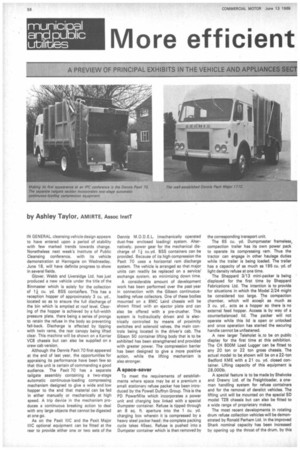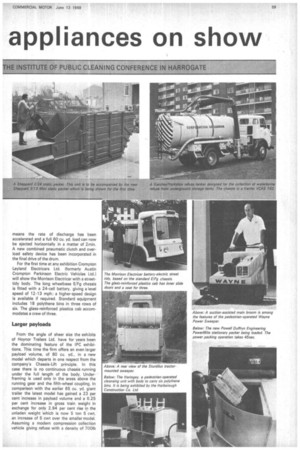More efficient appliances on show
Page 60

Page 61

Page 62

Page 67

If you've noticed an error in this article please click here to report it so we can fix it.
IN GENERAL, ceansing vehicle design appears to have entered upon a period of stability with few marked trends towards change. Nonetheless next week's Institute of Public Cleansing conference, with its vehicle demonstration at Harrogate on Wednesday. June 18, will have definite progress to show in several fields.
Glover. Webb and Liversidge Ltd. has just produced a new vehicle under the title of the Binmaster which is solely for the collection of 1+ co. yd. BSS contairlers. This has a reception hopper of approximately 3 cu. yd., located so as to ensure the full discharge of the bin which is emptied at roof level. Clearing of the hopper is achieved by a full-width pressure plate, there being a series of prongs to retain the refuse in the body so preventing fall-back. Discharge is effected by tipping with twin rams, the rear canopy being lifted clear. This machine will be shown on a Karrier VC8 chassis but can also be supplied on a crew cab version.
Although the Dennis Paxit 70 first appeared at the end of last year, the opportunities for appraising its performance have been few so that this unit is certain of commanding a good audience. The Paxit 70 has a separate tailgate assembly containing a two-stage automatic continuous-loading compressing mechanism designed to give a wide and low hopper to the end that material can be fed in either manually or mechanically at high speed. A trip device in the mechanism produces a continuous breaking action to deal with any large objects that cannot be digested at one go.
As on the Paxit IIIC and the Paxit Major WC optional equipment can be fitted at the rear to provide either one Or two sets of the Dennis M.O. D. E. L. (mechanically operated dust-free enclosed loading) system. Alternatively, power gear for the mechanical discharge of 1+ cu.yd. BSS containers can be provided. Because of its high compression the Paxit 70 uses a horizontal ram discharge system. The vehicle is arranged so that major units can readily be replaced on a service/ exchange system. so minimizing down time.
A considerable amount of development work has been performed over the past year in connection with the Gibson continuousloading refuse collectors. One of these bodies mounted on a BMC Laird chassis will be shown fitted with an ejector plate and can also be offered with a pre-crusher. This system is hydraulically driven and is electrically controlled by means of proximity switches and solenoid valves, the main controls being located in the driver's cab. The Gibson 50 container lifting body that is to be exhibited has been strengthened and provided with greater power. The compression barrier has been designed to give a more positive action, while the lifting mechanism is also stronger.
A space-saver
To meet the requirements of establishments where space may be at a premium a small stationary refuse packer has been introduced by the Powell Duffryn Group. This is the PD PowerMite which incorporates a power unit and charging box linked with a special Dumpster container. Refuse is tipped through an 8 sq. ft. aperture into the 1 cu. yd. charging box wherein it is compressed by a heavy steel packer head: the complete packing Cycle takes 45sec. Refuse is pushed into a Dumpster container which is then removed by the corresponding transport unit.
The 65 Cu. yd. Dumpmaster frameless. compaction trailer has its own power pack to operate its compressing ram. Thus the tractor can engage in other haulage duties while the trailer is being loaded. The trailer has a capacity of as much as 196 cu. yd. of light density refuse at one time.
The Sheppard 3/13 mini-packer is being displayed for the first time by Sheppard Fabrications Ltd. The intention is to provide for situations in which the Model 2/24 might be considered too large. The compaction chamber, which will accept as much as 3 cu. yd., acts as a hopper so there is no external feed hopper. Access is by way of a counterbalanced lid. The packer will not operate while this lid is open or unlocked and once operation has started the securing handle cannot be unfastened.
A new larger Telehoist is to be on public display for the first time at this exhibition. The CH BOOM Load Lugger can be fitted to any 20 ton or 22 ton gross chassis. The actual model to be shown will be on a 22-ton Bedford KME with a 21 cu. yd. closed container. Lifting capacity of this equipment is 28,000lb.
A special feature is to be made by Shelvoke and Drewry Ltd. of its Freightloader, a oneman handling system for refuse containers and for the removal of derelict vehicles. The lifting unit will be mounted on the special SD model TZB chassis but can also be fitted to a wide range of proprietary makes.
The most recent developments in rotating drum refuse collection vehicles will be demonstrated by Ronald Perham Ltd. In the improved Shark nominal capacity has been increased by opening up the throat of the drum, by this means the rate of discharge has been accelerated and a full 60 cu. yd. load can now be ejected horizontally in a matter of 2min. A new combined pneumatic clutch and overload safety device has been incorporated in the final drive of the drum.
For the first time at any exhibition Crompton Leyland Electricars Ltd. (formerly Austin Crompton Parkinson Electric Vehicles Ltd.) will show the Morrison Electricar with a streettidy body. The long wheelbase E/Fg chassis is fitted with a 24-cell battery, giving a level speed of 12-13 mph; a higher-speed design is available if required. Standard equipment includes 18 polythene bins in three rows of six. The glass-reinforced plastics cab accommodates a crew of three.
Larger payloads
From the angle of sheer size the exhibits of Hoynor Trailers Ltd. have for years been the dominating feature of the IPC exhibitions. This time the firm offers an even larger payload volume, of 80 cu. yd., in a new model which departs in one respect from the company's Chassis-Lift principle. In this case there is no continuous chassis running under the full length of the body. Underframing is used only in the areas above the running gear and the fifth-wheel coupling. In comparison with the earlier 65 Cu. yd. giant trailer the latest model has gained a 23 per cent increase in payload volume and a 6.25 per cent increase in gross train weight in exchange for only 2.94 per cent rise in the unladen weight "which is now 5 ton 5 cwt, an increase of 5 cwt over the smaller model. Assuming a modern compression collection vehicle giving refuse with a density of 700lb per cu.yd., the 65 cu.yd. trailer with a 4-ton 18cwt tractor will carry a 20-ton payload at a 30-ton g.t.w. On the same density basis the new trailer will carry 21 tons 17cwt. The actual capacity would be 25 tons but that would not fall within the legal requirements.
In place of the tandem-axle bogie of the smaller model the 80 cu.yd. has a triple-axle but it can be operated with the same tractor, so long as it is correctly plated. without alteration to the fifth-wheel position. Overall length of the body is 33ft and width 8ft, body sides are 3ft 6in. high and overall height is 13ft,
Local authority mini
Under the name of Compactra, the Chipman Chemical Co. Ltd. is offering a mini-tractor for local authority work, its scope covering such duties as salting, gritting, snow ploughing and weed spraying. Standard equipment includes a 12 hp air-cooled petrol engine with hydraulic transmission. One pedal controls the speed, there being a selector lever for forward and reverse and a further lever to actuate the hydraulic ram of the hopper. The vehicle can be fitted with a complete spraying assembly in under 5min. Research and development by the Chipman Chemical Co. Ltd. is being directed towards the production in a few years time of a gully emptier and vacuum road sweeper and for the immediate future to the possibilities of grass cutting equipment.
A new and larger Eagle Compressload model is to be shown by Hanger Engineering Ltd. Like the earlier Mark 3 and Mark 5 the Compressload 7 employs the principle of ram discharge without tipping. The body, which provides for a 7-ton payload, has internal measurements of 10ft 9in, length, 7ft 8in, width and 5ft 4in. height. It will be mounted on a Ford D1000 179in. wheelbase chassis.
Shefflex Ltd. returns to the IPC exhibition with its well-established Super Pack collector body with the Shefflex dustless shutter for use with ordinary domestic bins.
Appearing for the first time at the conference is the Pathmaster 42 sweeper by Blew Knox Ltd. A Hillman Imp 1375 c.c. power unit is mounted on the chassis beneath the hopper, giving a travelling speed up to 28 mph and a working speed of 12 mph: there is a fourspeed gearbox with syncromesh on all forward gears and reduction gears in each of the rear wheels. The hopper has a 16 cu.ft. capacity and is raised by twin rams. In order to aid manoeuvring the Pathmaster has a turning circle of 18ft and a taper-sided cab. The 42in. wide main brush is lifted hydraulically so that the sweeper can ride over kerbs up to 6in. high without need for ramps. This main broom is driven hydraulically from the engine;
THE various cleansing services within the London Borough of Wandsworth have, in the past, followed the conventional set-up of combining orderly trucks with both pedestrian and ride-on electric trucks. The men who sweep the pavements and streets of the second largest London borough are no different from any other town or borough in the country. Each had his own area of pavement and channel to sweep and this was known as his "beat".
The tools of the sweeper's trade were as seen in almost every other town or city in the United Kingdom—long handled brushes and shovels. His duty was to keep his beat clean and as free from litter as was reason Practices which in many cases were still the national norm were being scrutinized, and the accepted "cost for return" ratios were being examined.
Within this progressive climate a detailed investigation was undertaken and a review of the borough's cleansing services made. In particular the following questions were posed:— 3 Is the borough getting a fair return for the cost of the present cleansing service?
13 What are the strengths and weaknesses of the present service and can it be made more efficient?
3 Is a programme of mechanization feas with their brooms and shovels tried hard to perform a good job, technically they could not compete with almost any equipment working on an efficient suction principle. Possibly the final deciding link in the chain was a firm conviction that the economic advantages of a fully mechanized service would be so great that the men operating within it could possibly participate in a substantial weekly bonus payment. With these thoughts in mind the borough and its Work Study Group, in conjunction with P-E Consulting Group Ltd., set out to test their beliefs.
The three main lines of investigation were: a To survey the entire borough for on
























































































































































